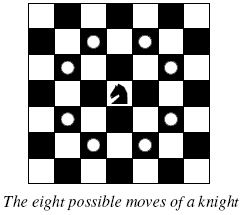 Background
Background
The knight is getting bored of seeing the same black and white squares again and again and has decided to make a journey
around the world. Whenever a knight moves, it is two squares in one direction and one square perpendicular to this. The world of a knight is the chessboard he is living on. Our knight lives on a chessboard that has a smaller area than a regular 8 * 8 board, but it is still rectangular. Can you help this adventurous knight to make travel plans?
Problem
Find a path such that the knight visits every square once. The knight can start and end on any square of the board.
Input
Output
If no such path exist, you should output impossible on a single line.
Sample Input
3 1 1 2 3 4 3
Sample Output
Scenario #1:A1Scenario #2:impossibleScenario #3:A1B3C1A2B4C2A3B1C3A4B2C4
代码:
#include<stdio.h>
#include<string.h>
#include<stdlib.h>
int t,n,m;
int s[26][26];//标记数组
char p[60];
static int dis[8][2]={-2, -1, -2, 1, -1, -2, -1, 2, 1, -2, 1, 2, 2, -1, 2, 1};//方向
int dfs(int x,int y,int mark)
{
if(mark==n*m) return 1;
int x1,y1;
for(int i=0;i<8;++i)
{
x1=x+dis[i][0];
y1=y+dis[i][1];
if(x1>=0&&x1<m&&y1>=0&&y1<n&&s[y1][x1]==0)
{
s[y1][x1]=1;
p[(mark<<1)]=x1+'A';//记录列
p[(mark<<1)+1]=y1+'1';//记录行
if(dfs(x1,y1,mark+1))
return 1;
s[y1][x1]=0;
}
}
return 0;
}
int main()
{
scanf("%d",&t);
for(int i=1;i<=t;i++)
{
scanf("%d %d",&n,&m);
memset(s,0,sizeof(s));
memset(p,0,sizeof(p));
s[0][0]=1;
p[0]='A';
p[1]='1';
if(dfs(0,0,1))
{
printf("Scenario #%d:\n",i);
for(int j=0;j<strlen(p);j++)
printf("%c",p[j]);
printf("\n\n");
}
else
{
printf("Scenario #%d:\nimpossible\n\n",i);
}
}
return 0;
}







 本文探讨了骑士周游问题的解决方法,即如何在一个缩小版的国际象棋棋盘上,让骑士按照特定的移动规则走过每一个格子恰好一次。通过深度优先搜索和回溯算法,文章提供了一个具体的实现方案,并附带了C语言代码示例。
本文探讨了骑士周游问题的解决方法,即如何在一个缩小版的国际象棋棋盘上,让骑士按照特定的移动规则走过每一个格子恰好一次。通过深度优先搜索和回溯算法,文章提供了一个具体的实现方案,并附带了C语言代码示例。
















 1100
1100

 被折叠的 条评论
为什么被折叠?
被折叠的 条评论
为什么被折叠?








